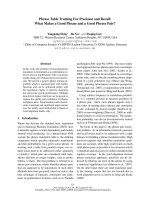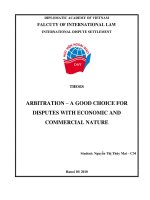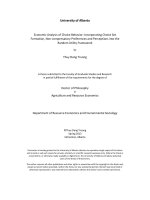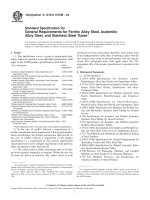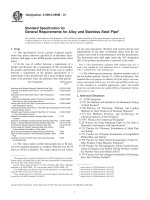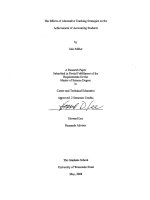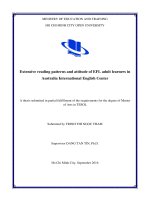Requirements for a good interpreter and translator and some suggestions for huflit students majoring interpretation and translation
Bạn đang xem bản rút gọn của tài liệu. Xem và tải ngay bản đầy đủ của tài liệu tại đây (27.86 MB, 77 trang )
I~
MINISTRY OF EDUCATION AND TRAINING
HO CHI MINH CITY UNIVERSITY OF FOREIGN
LANGUAGES -INFORMATION TECHNOLOGY
SCHOOL OF FOREIGN LANGUAGES
GRAD ATION PAPER
REQUIREMENTS FOR A GOOD INTERPRETER
AND TRANSLATOR
& SO E SUGGESTIONS FOR HUFLIT
STUDENTS MAJORING IN INTERPRETATION
AND TRANSLATION
ADVISOR
:
STUDENT
:
STUDENT'S NUMBER:
CLASS
:
MR. NGUYEN TRi lOI
TRAN THI lONG vA
~. ..
0071020
BA0001
TV DQi Hqc Huflit
1111111111111111111111111111
101000500
HO CHI MINH CITY. JULY 20004
MINISTRY OF EDUCATION AND TRAINING
HO CHI MINH CITY UNIVERSITY OF FOREIGN
LANGUAGES -INFORMATION TECHNOLOGY
SCHOOL OF FOREIGN LANGUAGES
GRADUATION PAPER
REQUIREMENTS FOR A GOOD INTERPRETER
AND TRANSLATOR
& SOME SUGGESTIONS FOR HUFLIT
STUDENTS MAJORING IN INTERPRETATION
AND TRANSLATION
H~/FL11
ADVISOR
:
STUDENT
:
STUDENT'S NUMBER :
CLASS
:
MR. NGUYEN TRI LOI
TRAN TH! LONG VAN
0071020
BA0001
~,
/
.~".;----
I.....
-<'YTHIJVIEN
~. ".
.
,"':'
~
~9(H\.~
-
---~-
--
.~
111
'-s-t::.
•.H CITY,
JULY 20004
.•.••.•..................................•.•••••.•..•............•..•.•••••••••...............
.
...
...
.
....
.
'. ..~
......
.. ..
..
..
.................................................................................. ~
l
Table of Contents
Table of Contents
Acknowledgement
Abstract
Introduction
Method
CHAPTER ONE:
OVERVIEW OF INTERPRETATION & TRANSLATION
1.1. What is translation?
1.1.1. Word-for-word translation
1.1.2. Literal translation
1.1.3. Faithful translation
1.1.4. Semantic translation
1.1.5. Adaptation
1.1.6. Free translation
1.1.7. Idiomatic translation
1.1.8. Communicative translation
1.2. What is interpretation ?
1.2.1. Conference interpreting
a) Consecutive interpreting
b) Simultaneous interpreting
c) Whispering
d) Bilateral
1.2.2. Community interpreting
1.2.3. Court interpreting
1.2.4. Other types of interpreting
a) Media interpreting
b) Remote interpreting
c) Videoconference
1.3. Interpreters versus Translators
CHAPTER TWO:
Page
1
2
2
3
3
3
4
4
5
5
6
6
7
11
16
16
16
16
16
16
17
17
18
REQUIREMENTS FOR A GOOD ENGLISH - VIETNAMESE I
VIETNAMESE - ENGLISH INTEPRETER & TRANSLATOR
20
2.1. Common requirements for both interpreters and translators
2.1.1. Good command of the two languages
20
20
a) Linguistic knowledge
b) Cultural Literacy
2.1.2. Good knowledge of the fields they are involved in
2.1.3. High responsibility and the passion for their jobs
2.1.4. Great intellectual curiosity and ability to use various
information-providing sources effectively
20
25
26
28
29
2.2. Particular requirements for a good interpreter
2.2.1. Good listening and speaking skills
2.2.2. Good memory and note-taking technique
2.2.3. Broad social knowledge and sharp mind
2.2.4. Good power of concentration and quick reaction
2.2.5. Good health and ability to handle stress
30
30
32
33
33
34
2.3. Particular requirements for a good translator
2.3.1. Excellent reading comprehension ability
2.3.2. Excellent writing ability
2.3.4. Patience
35
35
35
36
CHAPTER THREE:
WHAT HUFLIT STUDENTS MAJORING IN INTERPRETATION
& TRANSLATION COULD APPLY IN REAL SITUATIONS
38
3.1. Overview of the curriculum of interpretation and translation
major in the Department of English
38
3.2. Difficulties still faced by HUFLIT seniors when studying
interpretation and translation
3.2.1. Difficulties in translation
3.2.2. Difficulties in interpretation
42
3.3. Problems faced by the seniors who have taken
real jobs in interpretation and translation field
CHAPTER FOUR:
SOME SUGGESTIONS
42
47
50
55
4.1. Some suggestions for improving interpretation
and translation achievements
55
4.2. Some practical experiences of the professional interpreters
and translators
57
CHAPTER FIVE:
CONCLUSION
5.1. Conclusion
5.2. Limitation and Implication
59
59
61
Appendix
1. Exerecises to develop and improve simultaneous interpreting skills
2. Questionnaires
Bibliography
: ••••••••.. -"'1 :::':~'~••".'
.
•• """"""'.""""""""""""""""""""""""""'.""""""""".""""""."""".'
•••••••••••••••
":
":
:
................ :
c. :::-::':.:
/
Acknowledgements
First of all, I am grateful to the
School of Foreign
Languages of HUFLIT for giving me an opportunity
to carry
out my paper.
I would
specially express my sincere thanks
to Mr.:
Nguyen Tri Loi, my advisor, who provided me with materials
as well as gave me valuable suggestions, criticsm, comments,
and correction.
I wish to express my special gratitude
to the seven
professors of HUFLIT and five professional interpreters
and
translators who saved their time for my interviews. Thanks to
their ideas and experience, I could accomplish this paper.
My special thanks also goes to Mr. Nguyen Van Ly and
Ms. Bui Thi Thanh Truc for providing me with useful materials
and advice.
I would like to convey my thanks to my classmates for
their help in filling out the questionaires.
Last but not least, I would like to express my gratefulness
j
j
............
..
~
\~
to my family, especially my mother, and all my best friends for
supporting me to fulfil this graduation paper .
-.~\.....)
.. ,::
..
..
....... _.::::
/
".
}
~
.
Abstract
Going along with the global economic integration of our country is the increasing
demand for good interpreters and translators. As a HUFLIT student majoring in
interpretation and translation I really want to know what the requirements for a good
interpreter and translator are. Therefore, this mini research aimed at (1) figuring out
the requirements for a good English - Vietnamese / Vietnamese - English interpreter
and translator, (2) finding out what HUFLIT students majoring in interpretation and
translation
could apply in real situations,
suggestions for interpretation
(3) to give HUFLIT students some
and translation achivement.
interviewing seven professors teaching interpretation &
It was carried out by
translation at HUFLIT and
five people working in the translation fields to find out the requirements for a good
English-Vietnamese / Vietnamese -English interpreter and translator.
It was found that the common requirements for a good interpreter and translator
are: having good command of the two languages, good knowledge of the fields they
are involved in, high responsibility, the passion for their jobs, great intellectual
curiosity and ability to use various information -
providing sources effectively.
Besides, a good interpreter need good speaking and listening skills, good memory
and note - taking technique, good power of concentration and quick reaction, good
health and ability to handle stress as well as broad social knowledge and sharp mind; a good translator need excellent reading and writing ability and patience.
The two questionnaires were also designed for forty-two students of the class
BA0001 to figure out their difficulties when studying interpretation and translation. It
was found that the difficulties still faced by most of the seniors when studying
interpretation and translation are vocabulary, idioms, writing, listening, speaking and
note - taking.
It is suggested that HUFLIT students majoring in interpretation and translation
should be provided with the knowledge of one or two particular fields. Some possible
ways to improve interpretation and translation as well as some practical experiences
of the professional
interpreters and translators are also given to them. Further
research could be done on special requirements for particular kind of interpreting like
conference interpreting, court interpreting, media interpreting or particular kind of
translation like literature translation, business translation, eel...
INTRODUCTION
Our mind is mainly fed by two ways, reading and listening.
How we
can approach the new advances in science and technology all over the world if
the information about them is not translated into the language we know. How
we can have chances to enjoy the world's famous books, novels, poems unless
they are translated
translators
help
into the language
people
from
we know. Through
different
cultures
be
their versions,
able
to exchange
information, knowledge ...
Besides translators, there is another "language messenger" whose job is
to help people speaking different languages contact directly, face to face. They
are called interpreters. Whether two representatives
from two countries are
meeting to discuss economic problems in an intimate setting or at a summit
which is being held for leaders from dozens of countries, the interpreter' role is
pivotal.
Interpreters
and translators
really play an important
role in
global
economic integration as well as in cross-culture. Therefore, in 1994, when the
open
economic
Interpretation
policy
has been carried
& Translation
out for eight years,
the first
Company in Ho Chi Minh City was officially
came into existence. Up to now, our city has had more than 72 ones. This figure
shows that the demand for interpreters & translators is increasing.
However, there's still no school providing a full curriculum for students
to be professional interpreters and translators in Ho Chi Minh City. They are
usually known as well-paid jobs but not everybody knows how they m:e
practised and what their requirements
are. Many Vieh1amese people may
think that if they are good at English they can become good English Vieh1amese / Vietnamese - English
linguistic
skills only are not enough.
interpreters
and translators.
There are hundreds
In fact,
of students
1
graduating from School of Foreign Languages every year but not all of them
can become good interpreters and translators. One of the reasons is that they
know quite little about the requirements for these professions and how to meet
them.
This mini research was carried out
(1) to find out the requirements for a good English- Vietnamese/ VietnameseEnglish interpreter and translator,
(2) to figure out what
HUFLIT students majorIng in interpretation
and
translation could apply in real situations,
(3) to give HUFLIT students
some suggestions
for interpretation
and
translation achivement.
It opens with an overview of interpretation and translation in chapter
one. It goes on to present the requirements for a good English - Vietnamese /
Vietnamese - English interpreter and translator in chapter two. What HUFLIT
students of interpretation and translation major could apply in real situations
are mentioned in chapter three and followed by some suggestions in chapter
four. It closes with the conclusion in chapter five.
MEmOD
This research paper was carried out by collecting relevant information
from books, newspapers
and internet; making interviews and distributing
questionnaires.
I
Firstly, I read books, newspapers
and surfed the net looking for
information on translation and interpretation. /
Secondly,
interpretation
I interviewed
seven professors
teaching
translation
and
in Ho Chi Minh City University of Foreign Languages and
Information Technology (HUFLIT) and five people working in the translation
fields to find out the requirements
Vietnamese - English interpreter
people usually
for a good English - Vietnamese /
and translator as well as the difficulties
cope with when translating
or interpreting
English into
Vietnamese and vice versa.
Thirdly, two / questionnaires
were distributed
seniors majoring in interpretation and translation}The
designed
to,l find out their difficulties
translation/Then,
to forty-two HUFLIT
first questionaire was
while studying
interpreting
and
the second one was designed toAigure out some subjective
reasons that may cause those difficulties.
.
/ Finally, the data were analyzed/based on comparision and percentage.
GRADUATION
Advisor: Mr. NGUY~N TRi LO'I
PAPER
CHAPTER ONE
OVERVIEW OF INTERPRETATION & TRANSLATION
Leila Razmjou ( To Be A Good Translator. Online Translation Journal,
Volume
8,
No.2,
April
2004
<!journaI/20edu.htm>)
[accessed
April
2004].
stated that a nation's culture
flourishes by interacting with other cultures. Cultural variety opens our eyes to
human rights, but cultural variety can only be recognized through discussions,
which leads us to the major tool for discussion: "language." The role of
language
in the developing
world
is materialized
through
"translating".
Without a doubt, translation is essential for making communication
between
people of different cultures possible ( Translation Journal and the Author 2003
on-line [accessed April 2004]. Philosophy, Anthropology,
and Linguistics in
Translation
Anelo,
by
Carmen
Guarddon
< />
Ph.D.
). Therefore, translation is
one of the oldest human practices both in written and oral forms. The first
traces of translation date from 3000 Be, during the Egyptian Old Kingdom, in
the area of the First Cataract, Elephantine, where inscriptions in two languages
have been found ( Peter Newmark. Approaches to Translntion,3).
However, the significant roles of translators and interpreters were not
always highly evaluated. According to Susan Bassnett - McGuire (Translation
Studies,13), translation
has been perceived
as a secondary
activity, as a
mechanical rather than a " creative" process, within the competence of anyone
with a basic grounding in a language other than their own; in short, as a low
status occupation. But that perception is changing now. The more exchange of
information
and cutural contacts are made all over the world the more
important translation and interpretation are.
Student:
Tran Thi Long Van
Page I
GRADUATION
Advisor: Mr. NGUY~N TRi LO'I
PAPER
As this research paper emphasizes
on the requirements
for a good
interpreter and translator, it is necessary to mention the general knowledge of
translation and interpretation.
1.1. What is translation?
Translation is the transmission of a thought expressed in one language
by means of another language. The language used to express the thought
directly is called "the Source Language"
(SL), and the language used to
translate that thought is called" the Target language" (TL)
(Translation 1. HUFLIT English Department, 2002).
According to Peter Newmark ( Approaches to Translation, 1988), the most
common methods that have been used throughout the translation history are:
word-for-word
translation,
translation,
adaptation,
literal translation,
free
translation,
faithful translation,
idiomatic
semantic
translation
and
communicative translation. They will be briefly discussed below
1.1.1. Word -for - word translation:
This is often demonstrated
immediately
as interlinear
translation,
with the TL
below the SL words. The SL word order is preserved and the
words translated singly by their most common meanings, out of context. This
method
is normally
effective only for brief, simple sentences where the
grammatical and lexical structures of the SL and TL happen to coincide.
For example: I usually get up late on Sunday.
T6i thuo-ng thfrc d~y tr2 vao chu nh~t.
Most of the time, this method produces a very unnatural, awkward translation
Student:
Page 2
Tran Thi Long Van
/
GRADUATION
Advisor: Mr. NGUY~N TRI LO'I
PAPER
1.1.2. Literal translation:
This
is an
grammatical
improvement
constructions
over
word-for-word
are converted
the lexical words are again translated
version is more comprehensible
most of the time, unnatural
For example:
translation.
The SL
to their nearest TL equivalents
but
singly, out of context. As a result, the
than a word-for-word
translation
but it is still,
and possibly misleading.
This car was repaired by Peter.
Chi~c xe hoi nay duQ'c sua boi Peter. ( Word-for-word
translation)
Chi~c xe hoi nay duQ'c Peter sua. ( Literal translation)
1.1.3. Faithful translation:
A faithful
meaning
translation
of the original
structures.
It "transfers"
grammatical
attempts
within
to reproduce
the constraints
cultural
words
and lexical "abnormality"
and
the preCIse contextual
of the TL grammatical
preserved
in the translation.
completely faithful to the intentions and the text-realization
the
degree
It attempts
of
to be
of the SL writer.
For example: " Men eat like horses"
" Nam t1wc nhu h6"
1.1.4. Semantic translation:
This is a further improvement
over faithful translation,
attempting
to
render the exact contextual
meaning of the original, as closely as the semantic
and syntactic/
structures
translation"
grammatical
the TL allows. It differs from"
only in that it must take into account of the aesthetic value ( that is
the beautiful and natural sound) of the SL text, compromising
where appropriate
finished
version.
uncompromising
Student:
faithful
so that no assonance,
The main distinction
word-play
between
on " meaning"
or repetition
jars in the
the two is that the first is
and dogmatic while the second is more flexible.
Tran Thi Long Van
Page 3
GRADUATION
PAPER
Advisor: Mr. NGUY~N TRi LO'I
For example: Could you speak louder, please?
Ong vui long n6i IOnhan Qugc khOng? (faithful translation)
Xin 6ng vui long n6i IOnhan. ( semantic translation)
1.1.5. Adaptation:
In an attempt to produce a version of the original that sounds natural
and interesting for the readership, adaptation has been adopted. This is the
"freest" form of translation. It is used mainly for plays, novels and poetry. The
themes, characters, plots are usually preserved, the SL culture conv!:rted to the
TL culture and the text rewritten. It is doubted if this should be called a
translation, as the translator can choose to convey to the readership what in the
original that is interesting and/ or easy to understand while omitting the rest or
adding so much of his own interpretation.
1.1.6. Free translation:
Free translation has been adopted as a reaction to the limitations of the
literal translation. It attempts to reproduce the matter without the manner, or
the content without the form of the original, thus resulting in a natural
translation. Usually, it is a paraphase much longer than the original, a so-called
"intra-lingual translation", often lengthy and preten.tious, and not translation
at all.
For example:
Banh chung: Square glutinous rice cake (filled with green bean
paste and fat pork)
Student:
Tran Thi Long Van
Page 4
GRADUATION
Advisor:
PAPER
Mr. NGUY~N
TRi LO'I
1.1.7. Idiomatic translation:
111is method reproduces
the "message"
of the original, rendering a
lively, natural translation by preferring colloquiallisms and idioms where these
do not exist in the original. By doing so, it tends to distort the nuances of
meaning.
For example: "As easy as ABC"
"D~ nhu tra ban tay"
1.1.8. Communicative translation:
This method attempts to render the exact contextual meaning of the
oringinal in such a way that both content and language are readily acceptable
and comprehensible
transmit
to the readership.
the thought
equivalents,
expressed
In terms of techniques, it tries to
in the SL by means of the nearest TL
regardless of word order, uses of words and expressions, of
tenses, structures and forms on the condition that the translation does not
sound queer and awkward.
In other words, it is more concerned with the
function than the form. This method allows the translator to correct or improve
the logic, to replace clumsy with elegants structures, to remove obscurities, to
exclude the less likely interpretations of an ambiguity, to eleminate repetition
and tautology, to modify and clarify jargon in an effort to produce a natural
translation. To contrast semantic translation with communicative translation,
Peter Newmark says that the former tends to over-translate while the latter
tends to under-translate.
For example: "CAm di tren co"
"It is forbidden to walk on the grass" (semantic h"anslation)
"Keep off the grass"
(communicative translation)
Among the eight methods mentioned above, semantic translation and
Student: Tri3n Thi Long Van
Page 5
GRADUATION
Advisor: Mr. NGUY~N TR[ LO'I
PAPER
communicative
translation are considered as the most effective methods. It is
hard to say which one is better, but just which is more appropriate
for a
particular situation.
(Nguy~n Van Ly. 2001. Approaches to Translation: Implications and Applications.
HUFLIT Thong Tin Khoa H9C;12/2001, 10, 11, 12, 13,14)
1.2. What is interpretation?
Although interpretation contains a strong element of translation, both
disciplines are quite different. Translation is written, interpreting spoken.
According to Nguyen Thanh Yen (ThllC Hanh Phien Djch Anh - Vi~t / Vi~tAnh, 12), when translation is mentioned in general the importance of
interpretation is ususally neglected. In fact, interpretation is more difficult than
translation because the interpreters have no time to check what they do not
understand and have almost no chance to correct their mistakes when
interpreting.
Different criteria lead to various classifications of interpretation. The
following is one of them.
1.2.1.Conference interpreting:
According to Valerie Taylor-Bouladon, conference interpreting today - as
opposed to interpreting as it has existed from time immemorial and which has
often been called the second oldest profession, started with the foundation of
the League of Nations,
(Conference Interpreting:
where everything
was interpreted
consecutively
Principles and Practice. Crawford House Publishing.
< />
int.html>
[accessed
April
2004]). So far,
conference interpreting is probably considered as the most widely known type
of interpreting. It now can be performed in different modes, which are:
Student:
Tran Thj Long Van
Page 6
Advisor: Mr. NGUY~N TRI LO'I
GRADUATION PAPER
a)
Consecutive interpreting
Either at a smaller gathering, during an official visit or
dinner, the interpreter takes notes of the original speech and
reproduces the entire statement in the target language. This
type
of interpretation
does not
required
any
technical
equipment but does require note-taking skills in addition to
language ones. Well-trained interpreters can render speeches of
10 minutes or more with great accuracy.
Example 1:
3 delegates speak language A,
3 delegates speak language B;
the interpreter understands and speaks both languages
and allows everyone to communicate. When delegate A
speaks, the interpreter works into language B and vice
versa
fA)
•
fA)
\
1lI
(A)
•
-..1
•,
•
Interpreter
I
0
Picture 1 : Delegate A speaking
Student: Tr€m Thj Long Van
Page 7
Advisor: Mr. NGUY~N TRi LO'I
GRADUATION PAPER
(A)
•
(B)
•
t7\
•
(A)
Delegate A speaking
Delegate A listening
W
(B\
Delegate B speaking
Delegate B listening
W
Interpreter
(A)
•
(A).-.
W
w
•I
•
t7\ •.••
(B)
•
•
I
(B)
•
Picture 4 : How an interpreter do consecutive interpreting
Example 2:
In many cases, interpreters will understand a language
without speaking it to perfection, which means it may be
preferable to use two interpreters:
Student : Tr~n Thi Long Van
Page 9
Advisor: Mr. NGUY~N TRi LO'I
GRADUATION PAPER
one to interpret from language A to language B, one to
interpret from language B to language A.
(A')
•
IInterpreter
\
-
t!\
•
/
3
(B)
W
Picture 5 : The interpreter 1 interprets from language A to Languge B
(A')
,~
W
I
t7\
•
Interpreter
21
~\
(B)
•
Picture 6 : the interpreter 2 interprets from language B to language A
Student : Tr~n Thj Long Van
Page 10
GRADUATION
Advisor: Mr. NGUY~N TRi LO'I
PAPER
b)
Simultaneous interpreting
Simultaneous
Nuremberg
interpretation
was
introduced
for
the
trials after the Second World War, when the
necessary technology was available. The old hands of the
League of Nations said disparagingly at the time that it was a
crazy idea, would probably not work and would certainly be
impossible to keep up (Valerie Taylor-Bouladon
( Conference
Interpreting: Principles and Practice ). Today, however, this type
of interpretation is the most common one used at conferences.
Interpreters doing simultaneous interpreting always work
in a group of two or three and are seated in a soundproof booth
ideally overlooking the conference. They receive the speaker's
contribution through headphones and interpret it into required
language for the participants. The delegate in the meeting room
selects the relevant channel to hear the interpretation
language
of his/her
choice through
headsets.
in the
The main
advantage of this type of interpreting is the simultaneity of the
interpretation that bring a saving in time, and the possibility of
having more than one language being interpreted at the same
times.
This is an example with three languages interpreted both
ways.The delegates may speak in any of the three languages
and can listen to the language they prefer.There are many
different possible configurations
of languages
or language
regimes.
StuJ~nt : Tran Thi Long Van
Pag~ 11
Advisor: Mr. NGUYE:N TRI LO'I
GRADUATION PAPER
(i;\.
•i
•
\
(;\f?i
•
•i
•
Picture 7 :Delegate A is speaking in language A which is simultaneously
interpreted into language B and language C
(i;\.
•
.,
fC\.
.,
/B\
The interpreter
Delegate A speaking
Delegate B listening
•
A
•
~
interpreting into
language B
The interpreter
interpreting into
language C
Delegate C listening
Student : Tr~n Thi Long Van
Page 12
Advisor: Mr. NGUYI::N TRi LO'I
GRADUATION PAPER
fA\
w
~/
(::\ I
••
I
m
•
Interpreting B
I
~
•
•
t
.".
fC\
w
Picture 8 : Delegate B is speaking in language B which is simultaneously
interpreted into language A and language C
m
•
fA\
Delegate B speaking
(::\
•
The interpreter
interpreting into
language A
Delegate A listening
W
Student: Tran Thi Long Van
Page 13
-I
Advisor:
GRADUATION PAPER
Picture 11 : Interpreting
Mr. NGUyr:N TRi LO'I
booth
Many conference venues have built-in booths and equipment for simultaneous
interpreting. The European Commission's main conference centre, the Centre de
Conference Albert Borschette (CCAB) has four meeting rooms with booths for
simultaneous
interpreting on each of the five floors
Picture 12 :The Commission's largest conference room in the Charlemagne
building has 22 booths.
( Directorate
General for Interpretation
[accessed May 2004]
< />
Student : Tr~n Thi
Long Van
fag en.htm»
Page 15
GRADUATION
Advisor: Mr. NGUYEN TR[ LOI
PAPER
c)
Whispering
This type of interpreting is also called' chuchotage' in
French. It resembles the simultaneous mode but is supplied
performed without a soundproof booth. Realistically an
interpreter can only 'whisper' if being seated/ standing
between up to three listeners at one time.
d)
Bilateral
This type of interreting is used when accompany clients on
specific visits, such as: companies, visits of factories, banks,
government
departments,
etc .... The interpreter works both
into and out of his / her mother tongue.
1.2.2. Community interpreting! Dialogue interpreting:
This type of interpreting
which it is performed:
derives its name from different settings In
hospitals, police stations, and for diferrents
clients: refugees, asylum seekers, etc. either on the phone or on person to
person.
1.2.3. Court interpreting:
This is restricted to a formal legal setting where the interpreter is the
mediator between solicitors, barristers, judges and the plaintiff accused
or defendant.
1.2.4. Other types of interpreting:
a)
Media interpreting
Interpreting
is also performed for the media, either on
television or for the cinema. Interpreters work for TV stations
on
ad
hoc basis,
Simultanous
Student:
Tran Thj Long Van
often
with
no
time
for preparation.
interpreting is also used at film festivals when
Page 16
